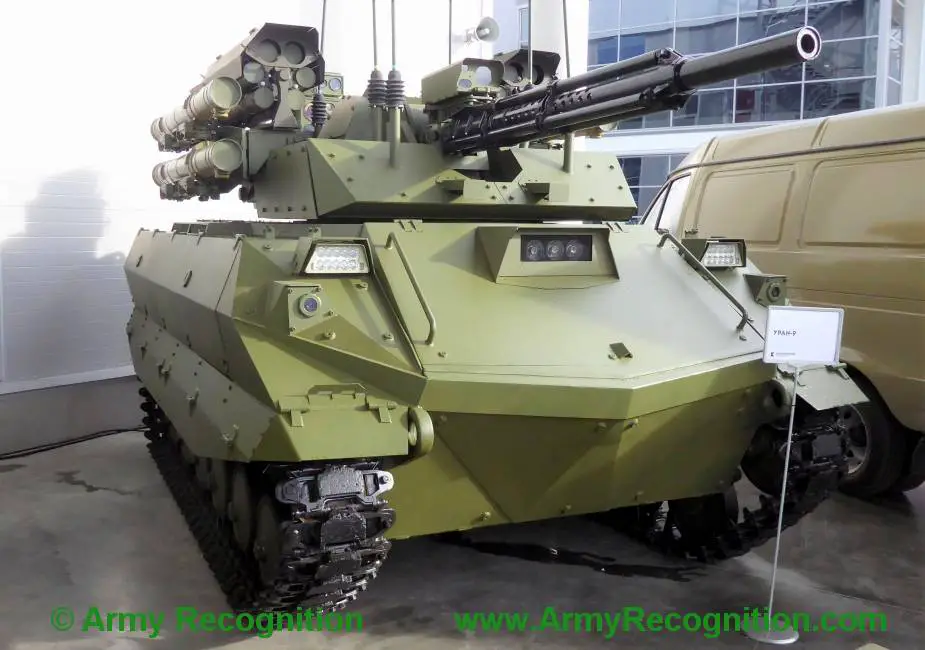Robots need adaptive complex protection – Part 2
The arms system is a cluster of weapons, types of armed forces and the armed forces in general designated for combat missions. The use of robotic systems is a relatively new component of the Ground Forces, which triggers specific interest. Retired Colonel PhD Technical Sciences V. Bebeshev and Lieutenant-Colonel PhD Technical Sciences D. Metelev research the problem of preserving the capability of ground assault robotic systems in combat in an article in the Voennaya Mysl (Military Thought) journal. They suggest ways to deal with the problem by creating a control system for complex protection based on the theory of functional systems.
Follow Army Recognition on Google News at this link

Uran-9 robotic system offers an example of motion control. It operates by the principle of one driver for four robots (Picture source: Army Recognition)
The electromagnetic and information impact is characterized by an uncertain level of destruction of ground robots. They can lose effectiveness gradually and it makes it difficult to expose the very fact of an impact. The most dangerous development is the hostile seizure of robot control. It is a major guideline in many countries, as it can potentially change the balance of forces due to control over adversary weapons.
Besides new impact tools, which objectively decrease the protection of robots compared to manned hardware, the robots themselves are sophisticated military systems with operational specific, which exerts a negative influence on their protection in combat.
Firstly, the detection of a weapon on the surrounding background depends on the camouflage against reconnaissance. Constant radio exchange between a mobile remote controller and a robot increases the chance of detection, while a big volume of the transmitted information and the capacity of transmitters considerably simplify the task for the adversary. As a rule, a robot uses a set of active tools, such as a laser ranger, lidar, radar, etc., which emit in various electromagnetic bands and expose the object to hostile reconnaissance.
Secondly, the protection of a manned vehicle depends on the skills of the crew to effectively engage arms, landscape folds, counteraction means, and active maneuvering.
Robots do not have such protective capabilities. Uran-9 robotic system offers an example of motion control. It operates by the principle of one driver for four robots and cannot fully use mobility for protection.
Thirdly, there are clear tasks and accrued statistics for manned hardware, which provide protection requirements for the main vehicles (tank, APC, IFV, etc.).
There is no statistic of robot engagement. The tactical situations, in which they can engage, are analyzed by simulation modeling. It results in unsubstantiated and low requirements to the constructive strength of some elements of combat robots. Some critical elements do not often have bullet resistance (outside monitoring elements, missile containers). Manned hardware with the same weapons has more reliable armor. It is a systemic drawback for all robots of the Russian industry.
It can be concluded that complex protection of robots should take into consideration the electromagnetic impact, as well as available information weapons, exposing factors of robot control, and the specifics of sophisticated functional structure of military robots.
A major aspect of robot protection is the principle of active control of all elements and systems that keep or restore the operability in conditions of a hostile impact. The proposed complex protection with an active command system is based on the principle. Complex protection can effectively operate if it is capable of making prudent conclusions by analyzing the incoming information on objects and real world scenes. It is impossible to do it without modern artificial intelligence technologies, technical vision, machine learning, and synergy of various scientific disciplines.
The command system chooses the type of actions according to the assigned target and current situation, forecasts the result of actions, and initiates command to act.
Complex protection needs artificial intelligence to implement the algorithm of actions. It will help, firstly, analyze incoming information, determine threat parameters, and transmit the decision for the execution by the protection system; secondly, analyze the result of actions and fulfil the task by several methods (keep the result, send it to related computers, use other algorithms); thirdly, learn in the process; and fourthly, operate in an agreed manner in a group (possibility to unite in groups with a distributed information processing center).
The theory of bionic systems (projection of physiological features of living organisms to the technical essence) prompts that the protection control system will use the same adaptive principles, which living organisms engage to ensure security. Artificial intelligence is the backbone of the system. It provides adaptivity, self-learning, and intuition (ability to decide on the basis of incomplete information).
The research of protection issues of high-tech modern robots exposes and resolves vital scientific problems in the general protection theory of sophisticated technical systems, such as weapons. It has a major defense importance and contributes to the development of the national military-industrial complex, retired Colonel PhD Technical Sciences V. Bebeshev and Lieutenant-Colonel PhD Technical Sciences D. Metelev write in the Voennaya Mysl (Military Thought) journal.
© Copyright 2021 TASS / Army Recognition Group SPRL. All rights reserved. This material may not be published, broadcast, rewritten or redistributed.


























